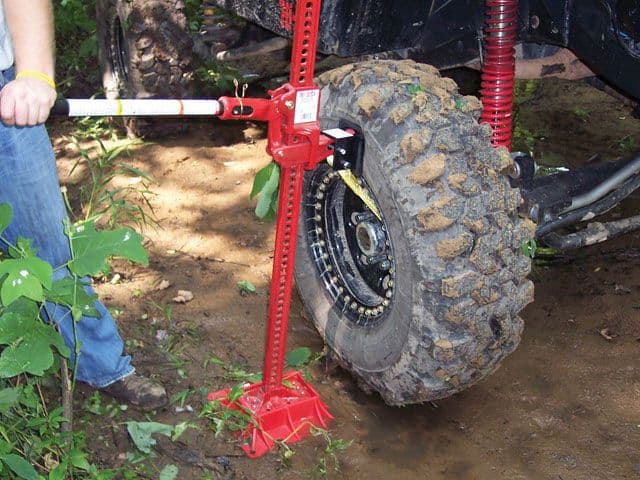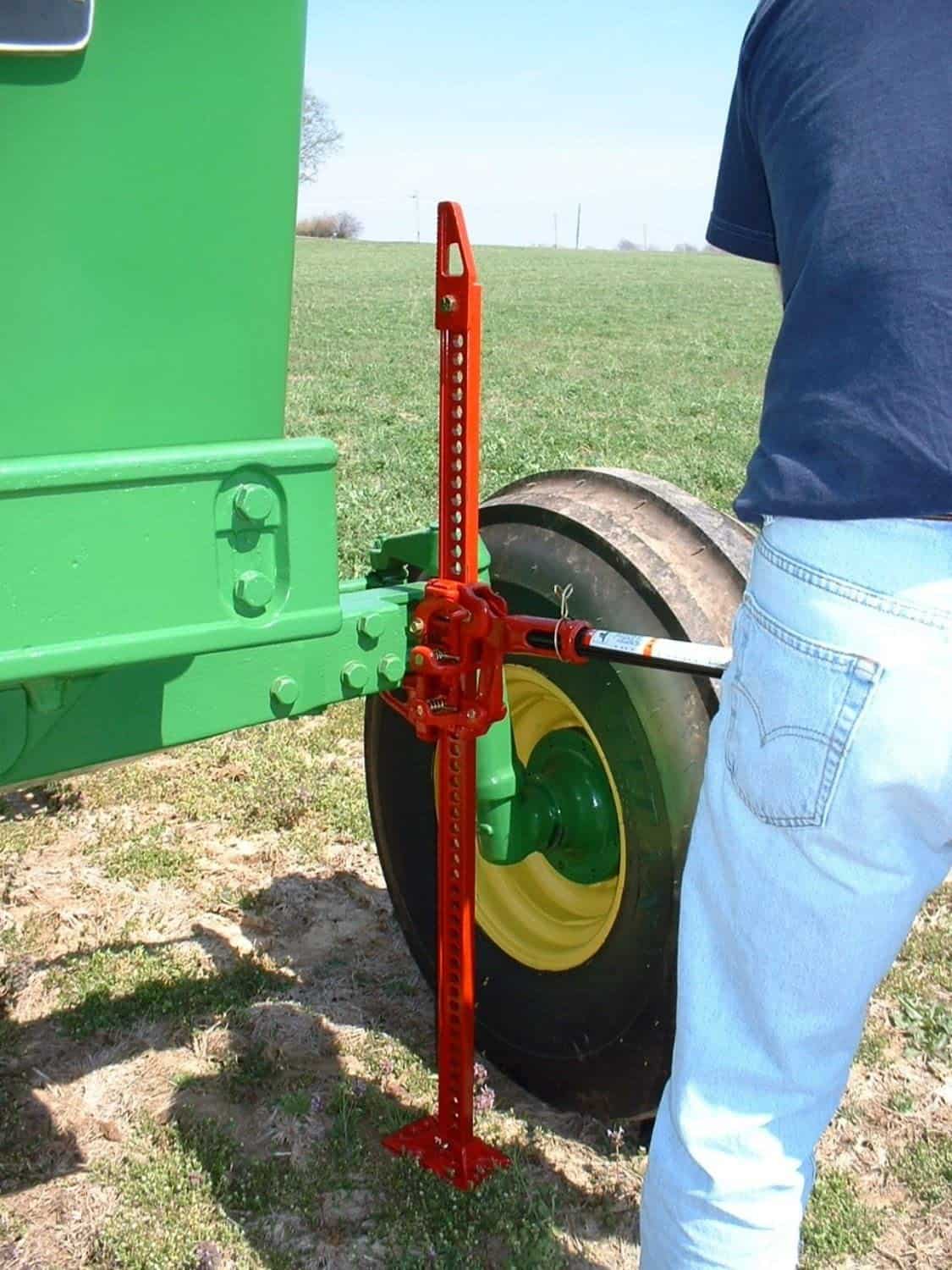Let’s face it, unexpected things can happen to your tractor. You could be halfway through a job and you get a flat tire.
But, there is no need to panic if you have a handy farm jack on hand to help you lift up the tractor. This way you can start doing repairs immediately.
Best of all, you can do all of the work safely if you follow our guide.

In this post we'll cover:
What is a farm jack?
Here’s the best Hi-Lift jack you can use to jack up a tractor:

First of all, you need to familiarize yourself with the farm jack. It’s a special kind of hi-jack that works best with large farm vehicles, especially tractors.
There are several sizes of jacks available. They are sold in different heights and sizes between 36 inches and all the way to 60 inches for very big tractors.
A farm jack is suitable to pull, winch, and lift, so it makes changing the tires safe and easy.
These jacks are not light, they weigh an average of about 40+ pounds, but they are easy to maneuver nonetheless.
The jack has a high load capacity of about 7000 pounds, therefore it’s very versatile.
At first glance, the farm jack looks a bit unsteady but that’s definitely not the case. The farm jack is the best choice for a tire change because it is sturdy and the tractor doesn’t fall over.
It goes low to the ground so you can even use it to jack up the skit steer.
But the best feature of this kind of jack is that you can use it on the spot on all surfaces, including grass, or on the field.
Since a farm jack is long it is the perfect size for any tall vehicle and tractor.
What to Do Before Jacking Up a Farm Tractor?
Before you jack up your tractor, consider using the special farm jack. A bottle jack or low profile jack doesn’t work well and it’s very dangerous. It can cause the tractor to fall.
If you use low profile jacks you need to stack them on top of each other, which again, is quite a safety hazard.
So, before you jack up the tractor, follow the steps below.
Ensure That The Spare Fits The Tractor Perfectly
Get a spare tire that will fit the tractor and one that is in good condition. This is important particularly if you have rented out the vehicle or if you are not the owner of the tractor. Sometimes, the tire can be smaller than the other tires.
Take Out The Tractor’s Spare Tire
The spare tire should always be removed before the vehicle is jacked up. This is because removing the spare tire while the vehicle has been jacked up could cause the tractor to move off the jack thus causing accidents. Of course, you should use the right farm jack for lifting your vehicle.
Prepare Your Farm Tractor
First, chock the tire that is in the opposite direction of the flat tire and set up the emergency brake. This process prevents the tractor from rolling over as you lift it on the jack.
You can use two large rocks to chock the tire in the opposite direction. Secondly, ask for assistance from roadside assistance services rather than changing the tire by yourself.
Loosen All The Lug Nuts
You cannot safely loosen the flat tire’s lug nuts if the tractor is in the air. It is easier to rotate lug nuts when there is some resistance. Also, loosening the nuts after jacking up the vehicle will only cause the tire to spin.
After you have taken all the necessary precautions, here is what you need to do when you want to jack up your tractor.
Seven Steps to Jack up a Farm Tractor
Step 1: Check the surface
Inspect the ground where the tractor will be parked. Ensure the surface is leveled, stable, and hard enough.
You can use a metal plate under the jack or jack stand to even out the load on uneven surfaces.
Step 2: Mark area
If you are on a busy road, you should place early warning signboards/signs a few meters behind the car to indicate your vehicle is under repair, and then engage the tractor’s parking brake.
Step 3: Find jack points
Locate the jack points; they are normally located in front of the rear wheels and a few inches behind the front wheels.
There are some jacking points placed under the rear and front bumpers. Nevertheless, when in doubt, you should always consult the manufacturer’s manual.
Step 4: Chock wheels
Chock the wheels that are on the opposite side so that they can remain on the ground.
Step 5: Position the jack
Grab the best farm jack or the hydraulic bottle jack and place it under the jack point.
You can then start lifting the tractor. To safely use the jack, place the handle in the appropriate position then pump it repeatedly to raise the farm tractor off the ground.
Raise the vehicle to a moderate height if you do not want to use jack stands.
Step 6: Double-check
If you want to do some maintenance or repairs under the vehicle, make sure that you insert the jack stands under the lifting points of the tractor. Check the position and jack.
Step 7: Finish
Bring the vehicle down after you are through with the maintenance or changing of the flat tire.
You should use the handle to lower the pressure and release the valve if you are either using a hydraulic jack or a floor jack before setting off. And then remove all the wheel chocks.
Jacking up a farm tractor is not a difficult skill. All the same, you should be careful when doing so to avoid fatal accidents or loss of life.
Other losses that you can experience from mishandling the farm tractor include loss due to reduced productivity, medical bills, insurance costs, and property damage.
How to use the Farm Jack Tool with blocks
For extra safety, you can use the Farm Jack tool with blocks.
To do this, here’s what you need:
- a farm jack
- leather work gloves
- blocks
Step one is to place your jack down on a FLAT surface if you can. If you use the jack in mud, it can move around and destabilize the tractor.
When you must, you can use it in the mud but use wood blocks to secure it.
The jack has a small rectangular base that holds it upright. But, it’s best to use a large wooden block and place the jack on top of that for extra stability.
The block must be stable and it shouldn’t move around.
Now, turn the jack’s knob so the lifting part can move up and down. Next, slide it all the way to the bottom part.
You have to turn the knob in the opposite direction and engage the jack. This lets it move up and down the handle until you find the desired height for your tractor.
Next, place the jack under the edge of the tractor that you are moving. Now make sure it’s secured. Make sure to slip the jack under the axle of the tractor.
Lift the jack handle and keep pressing down until the tractor is lifted to the height you want.
How do you jack up a mower tractor like the John Deere?
The easiest way to do this is with a floor jack.
Step one is to center your floor jack with either the front or the back of the mower tractor. Next, you must roll the floor jack right underneath the front axle or the rear axle.
It depends on how you want to do things. The next step involves twisting the floor handle in a clockwise direction. This tightens the hydraulic valve, which causes the floor jack to raise up.
How to reduce the likelihood of accidents while jacking up the tractor
Be Mentally and Physically Fit
Any person operating a tractor should be mentally and physically fit. Otherwise, certain factors like depression, poor judgment, insufficient knowledge, fatigue, or intoxication can cause a fatal accident.
Adequate Knowledge
Make sure that you have adequate knowledge that is required in the process. You can get the information from the manufacturer’s manual or conduct an online search of the guidelines.
Familiarize Yourself With The Operator’s Manual
Whenever you are changing a flat tire or repairing your tractor, first go through the operator’s manual.
The manual will indicate the process of all the repairs, and how you can deal with extreme cases. Learn all the safety procedures that you must adhere to for you to avoid accidents.
Conduct A Safety Check Whenever You Want To Use The Farm Tractor
Check if there are any obstacles near or under the tractor. Check if you have a flat tire or if the rear wheels are working appropriately. Lastly, check if there are any loose objects on the tractor.
Other safety tips that you should consider when jacking up your tractor include the following;
a. Use high lift jack stands whenever you are working underneath the tractor. More importantly, you should never go underneath the vehicle when a jack only holds it.
b. Use the jack and jack stands on a leveled ground.
c. Block the wheels before jacking up the tractor.
d. Use a jack to lift the tractor off the ground and not to hold it in its place.
e. Make sure that the parking brake of the track is engaged before jacking up the vehicle.
f. Gently shake the tractor after jacking it to ensure that it is secure before you can go under it.
g. Shut down the engine and the hydraulic pump while fixing a flat tire.
Conclusion
The tips mentioned above should help you when you want to quickly change your flat tire or carry out simple repairs on your vehicle.
Always keep in mind the three basic rules for jacking up a vehicle.
Did you know how to lower a high lift jack?
The three rules are; chock the wheels that are on the opposite axle of the tractor, use a jack that can support the weight of the load, and only work on a vehicle that has been appropriately jacked.
I'm Joost Nusselder, the founder of Tools Doctor, content marketer, and dad. I love trying out new equipment, and together with my team I've been creating in-depth blog articles since 2016 to help loyal readers with tools & crafting tips.
